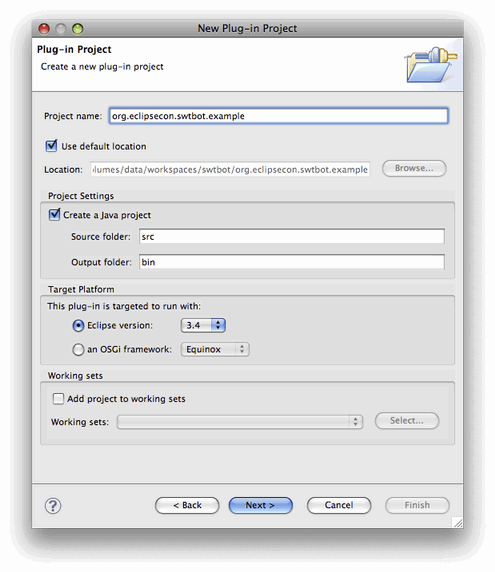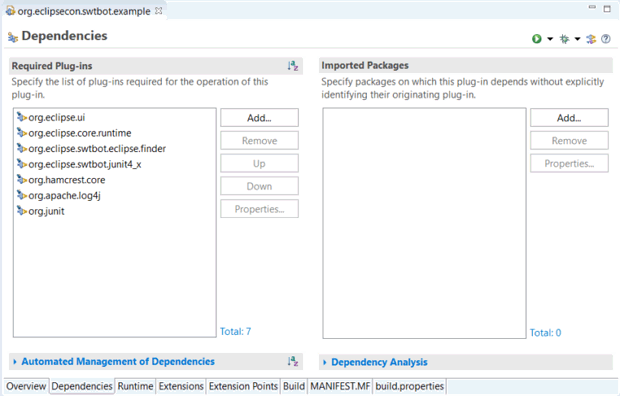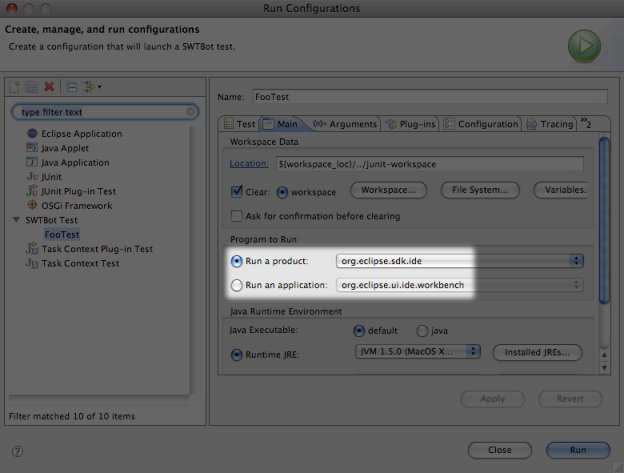Notice: This Wiki is now read only and edits are no longer possible. Please see: https://gitlab.eclipse.org/eclipsefdn/helpdesk/-/wikis/Wiki-shutdown-plan for the plan.
SWTBot/UsersGuide
| SWTBot |
| Website |
| Update Sites |
| Community |
| Mailing List |
| Forums/Newsgroups |
| IRC |
| Contribute |
| Open Bugzilla tickets |
| Open Gerrit reviews |
| Browse Source |
| Continuous Integration |
Contents
SWTBot Users Guide
Information on this page may be outdated.
Note that this page is for first time users. Advanced Users click here.
Introduction
SWTBot is an open-source Java based functional testing tool for testing SWT and Eclipse based applications.
SWTBot provides APIs that are simple to read and write. The APIs also hide the complexities involved with SWT and Eclipse. This makes it suitable for functional testing by everyone. SWTBot also provides its own set of assertions that are useful for SWT. You can also use your own assertion framework with SWTBot.
SWTBot can record and playback tests and integrates with Eclipse, and also provides for ant tasks so that you can run your builds from within CruiseControl or any other CI tool that you use.
SWTBot can run on all platforms that SWT runs on. Very few other testing tools provide such a wide variety of platforms.
Quick Start
A Screencast
Videos speak louder than pictures and words put together:
- A 5 minute quick quick tutorial on how to get started with swtbot
- Running SWTBot tests from the command line
Creating A Project
Create a new project by clicking on File>New>Project. On the New Project Dialog, search for "plug-in", select New Plug-in Project and click Next. Create a new plugin project named org.eclipsecon.swtbot.example.
Configuration
- Add the following to your classpath:
org.eclipse.ui org.eclipse.swtbot.eclipse.finder org.eclipse.swtbot.junit4_x org.hamcrest.core org.junit org.apache.log4j
Getting started with SWTBot
SWTBot requires that tests run on a non-UI thread, so that PlatformUI.getWorkbench() will return you null and that traditional unit-test code won't work. If you run tests on the UI thread, they will eventually block the UI at some point in time. Take a look into the FAQ for explanations and workaround.
Getting started with SWTBot for Eclipse Plugins
To use SWTBot along with your eclipse plugin application, add the plugin dependencies described above to your dependencies. You can download the example from the SWTBot download site http://download.eclipse.org/technology/swtbot/docs/eclipsecon2009/examples.zip.
Below you can find a sample SWTBot testcase:
package org.eclipsecon.swtbot.example; import org.eclipse.swtbot.eclipse.finder.SWTWorkbenchBot; import org.eclipse.swtbot.swt.finder.junit.SWTBotJunit4ClassRunner; import org.eclipse.swtbot.swt.finder.widgets.SWTBotShell; import org.junit.AfterClass; import org.junit.BeforeClass; import org.junit.Test; import org.junit.runner.RunWith; @RunWith(SWTBotJunit4ClassRunner.class) public class MyFirstTest { private static SWTWorkbenchBot bot; @BeforeClass public static void beforeClass() throws Exception { bot = new SWTWorkbenchBot(); bot.viewByTitle("Welcome").close(); } @Test public void canCreateANewJavaProject() throws Exception { bot.menu("File").menu("New").menu("Project...").click(); SWTBotShell shell = bot.shell("New Project"); shell.activate(); bot.tree().expandNode("Java").select("Java Project"); bot.button("Next >").click(); bot.textWithLabel("Project name:").setText("MyFirstProject"); bot.button("Finish").click(); // FIXME: assert that the project is actually created, for later } @AfterClass public static void sleep() { bot.sleep(2000); } }
Executing SWTBot Tests for Eclipse Plugins
Now that you've written the great test that you'd always wanted to, lets now see it run. In order to run the test, right click on the test and select Run As > SWTBot Test
Select the application that you want to test
GEF/GMF-based editor testing
Intro
SWT has a plugin that allows to manipulate GEF/GMF diagrams, editors and editParts as easily as you can manipulate SWT widgets with SWTBot. Then you can easily create some repeatable user-level UI interations and check their effects on the diagram
Configuration
The configuration is similar to the one describe before for SWTBot, except that you also have to add org.eclipse.swtbot.eclipse.gef.finder plugin and some other dependencies, such as org.eclipse.ui. In most case, you'll also like to use GEF and/or GMF plugins to make some checks on diagram.
Getting started with examples
If you like to get started with working examples, you can take a look at the following URL, or check them out in your workspace.
Example GEF project: http://git.eclipse.org/c/swtbot/org.eclipse.swtbot.git/tree/examples/gef/org.eclipse.gef.examples.logic
Example SWTBot for GEF test case: http://git.eclipse.org/c/swtbot/org.eclipse.swtbot.git/tree/examples/gef/org.eclipse.gef.examples.logic.test
General principles
Everything is almost the same as using SWTBot, except that some classes change in order to give you the ability to manipulate DiagramEditors. The SWTBotTestCase superclass must be replaced by SWTBotGefTestCase. From the inside of your SWTBotTestCase, you can access your SWTGefBot bot field to play with your GEF editor. Then you retrieve a SWTBotGefEditor by using bot.getEditor("label of my editor tab").
Once you have your SWTBotGefEditor, you can perform high level user operations programatically:
Creation of elements
// retrieve editor SWTBotGefEditor editor = bot.gefEditor("test.logic"); // editor must be already open // Simulate creation of element from palette editor.activateTool("Circuit"); // "Circuit" is the label of the tool in palette editor.mouseDrag(55, 55, 150, 100); editor.activateTool("Circuit"); editor.mouseMoveLeftClick(150, 150); editor.activateTool("Connection"); editor.mouseMoveLeftClick(150, 150); editor.mouseMoveLeftClick(55, 55);
Direct edition of editParts
SWTBotGefEditPart editPart = editor.getEditPart("edit part label"); // select edit part by label editPart.click(); editor.directEditType("new edit part label");
Perform a drag'n'drop
editor.mouseDrag(fromXPosition, fromYPosition, toXPosition, toYPosition)
Mix it with GEF/GMF to perform checks
TODO: create an example that ensure that creation of a specific element is not possible on mainEditPart
Recorder and Generator
SWTBot comes with a tool that generates some code based on events performed at runtime. It makes writing tests easier and faster. See SWTBot/Generator.
Migration to SLF4J logging
SWTBot 4.0.0 has removed its use of org.apache.log4j and is instead using the org.slf4j.api facade for its logging. See SWTBot/MigrationToSLF4J




